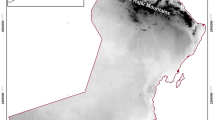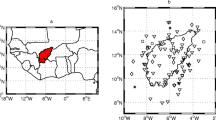Abstract
Climate change scenarios generated by general circulation models have too coarse a spatial resolution to be useful in planning disaster risk reduction and climate change adaptation strategies at regional to river basin scales. This study presents a new non-parametric statistical K-nearest neighbor algorithm for downscaling climate change scenarios for the Rohini River Basin in Nepal. The study is an introduction to the methodology and discusses its strengths and limitations within the context of hindcasting basin precipitation for the period of 1976–2006. The actual downscaled climate change projections are not presented here. In general, we find that this method is quite robust and well suited to the data-poor situations common in developing countries. The method is able to replicate historical rainfall values in most months, except for January, September, and October. As with any downscaling technique, whether numerical or statistical, data limitations significantly constrain model ability. The method was able to confirm that the dataset available for the Rohini Basin does not capture long-term climatology. Yet, we do find that the hindcasts generated with this methodology do have enough skill to warrant pursuit of downscaling climate change scenarios for this particularly poor and vulnerable region of the world.





Similar content being viewed by others
References
Anandhi A et al (2007) Downscaling precipitation to river basin in India for IPCC SRES scenarios using support vector machine. Int J Climatol. doi:10.1002/joc/1529
Charles SP et al (2004) Statistical downscaling of daily precipitation from observed and modeled atmospheric fields. Hydrol Process 18:1373–1394
Chow VT et al (1988) Applied hydrology. McGraw-Hill, New York
Christensen JH et al (2007) Regional climate projections. In: Solomon S et al (eds) Climate change 2007: the physical science basis. Contributions of Working Group I to the fourth assessment report of the intergovernmental panel on climate change. Cambridge University Press, Cambridge
Chung CE, Ramanathan V (2006) Weakening of North Indian SST gradients and the monsoon rainfall in India and the Sahel. J Climate 19:2036–2045
Dibike YB, Coulibaly P (2005) Hydrologic impact of climate change in the Saguenay watershed: comparison of downscaling methods and hydrologic models. J Hydrol 307:145–163
Dixit A et al (2007) Flood disaster impacts and responses in Nepal Tarai’s marginalised basins. In: Moench M, Dixit A (eds) Working with the winds of change: toward strategies for responding to the risks associated with climate change and other risks. ISET-International: Boulder and ISET-Nepal, Kathmandu, pp 119–157
Douville H (2006) Impact of regional SST anomalies on the Indian monsoon response to global warming in the CNRM climate model. J Climate 19:2008–2024
Fasullo J, Webster PJ (2003) A hydrologic definition of Indian monsoon onset and withdrawal. J Climate 16:3200–3211
Fedorov AV, Philander SG (2000) Is El Niño changing? Science 288:1997–2002
Fowler HJ, Kilsby CG (2002) Precipitation and the North Atlantic Oscillation: a study of climatic variability in Northern England. Int J Climatol 22:843–866
Fowler HJ, Belkinsop S, Tebaldi C (2007) Linking climate change modelling to impacts studies: recent advances in downscaling techniques for hydrological modelling. Int J Climatol 27:1547–1578
Gadgil S et al (2003) Droughts of the Indian summer monsoon: role of clouds over the Indian Ocean. Curr Sci 85(12):1713–1719
Gangopadhyay S et al (2005) Statistical downscaling using K-nearest neighbours. Water Resour Res 41:W0204
Hahn DG, Manabe S (1975) The role of mountains in the south Asian monsoon circulation. J Atmos Sci 32:1514–1541
Hoerling M, Kumar A (2003) The perfect ocean for drought. Science 2999:691–694
Ihara C et al (2006) Indian summer monsoon rainfall and its link with ENSO and Indian Ocean climate indices. Int J Climatol. doi:10.1002/joc.1394
India Water Portal (2008) http://www.indiawaterportal.org/data/metdata/. Accessed September, 2008
Kalnay E et al (1996) The NCEP/NCAR reanalysis 40-year project. Bull Am Meteorol Soc 77:437–471
Kinter JL III et al (2002) Recent change in the connection from the Asian Monsoon to ENSO. J Climate 15:1203–1215
Kripalani RH et al (2007) South Asian summer monsoon precipitation variability: coupled climate model simulations and projections under IPCC AR4. Theor Appl Climatol 90:133–159
Kulkarni A et al (2006) Association between extreme monsoons and the dipole mode over the Indian subcontinent. Meteorol Atmos Phys. doi:10.1007/s00703-006-0204-9
Kumar A et al (2001) Seasonal predictions, probabilistic verifications, and ensemble size. J Climate 14:1671–1676
Kumar KK et al (2006) Unraveling the mystery of Indian Monsoon failure during El Nino. Science 314:115–119
Lall U, Sharma A (1996) A nearest neighbor bootstrap for resampling hydrologic time series. Water Resour Res 32(3):679–693
Lau KM, Wu HT (2001) Principal modes of rainfall-SST variability of the Asian summer monsoon: a reassessment of the monsoon-ENSO relationship. J Climate 14:2880–2895
Littlewood IG et al (2007) Predicting daily streamflow using rainfall forecasts, a simple loss module and unit hydrographs: two Brazilian catchments. Environ Model Softw 22:1229–1239
Meehl GA, Arblaster JM (2002) The tropospheric biennial oscillation and Asian-Australian monsoon rainfall. J Climate 15:722–744
Mielke P et al (1997) A single-sample estimate of shrinkage in meteorological forecasting. Weather Forecast 12:847–858
Miller RB et al (1981) Modeling daily river flows with precipitation input. Water Resour Res 17(1):209–215
Müller WA et al (2005) A debiased ranked probability skill score to evaluate probabilistic ensemble forecasts with small ensemble sizes. J Climate 18:1513–1523
Murphy AH (1972) Scalar and vector partitions of the ranked probability score. Mon Weather Rev 100(10):701–708
Nepal Water Conservation Foundation (2006) Reconceptualizing flood mitigation in Tarai. NWCF, Kathmandu, p 168
Opitz-Stapleton S et al (2007) Generating streamflow forecasts for the Yakima River Basin using large-scale climate predictors. J Hydrol 341:131–143
Osborn TJ et al (1999) Evaluation of the North Atlantic oscillation as simulated by a climate model. Climate Dyn 15:685–702
Prairie J et al (2008) A stochastic nonparametric approach for streamflow generation combining observational and paleoreconstructed data. Water Resour Res 44:W06423. doi:10.1029/2007WR006684
Rajagopalan B, Lall U (1999) A k-nearest-neighbor simulator for daily precipitation and other weather variables. Water Resour Res 35(10):3089–3101
Reason CJC et al (2000) ENSO and climatic signals across the Indian Ocean basin in the global context: part 1. Interannual composite patterns. Int J Climatol 20:1285–1327
Slonosky VC et al (2001) Atmospheric circulation and surface temperature in Europe from the 18th century to 1995. Int J Climatol 21:63–75
Stanski HR et al (1989) Survey of common verification methods in meteorology. Research Report No. MSRB 89-5, Environment Canada, Atmospheric Environment Service
Tolika K et al (2006) An evaluation of a general circulation model (GCM) and the NCEP–NCAR reanalysis data for winter precipitation in Greece. Int J Climatol 26:935–955
Torrence C, Webster PJ (1999) Interdecadal changes in the ENSO-Monsoon System. J Climate 12:2679–2690
Trigo RM, Palutikof JP (2001) Precipitation scenarios over Iberia: a comparison between direct GCM output and different downscaling techniques. J Climate 14:4422–4446
Venables WN, Ripley BD (2002) Modern applied statistics with S, 4th edn. Springer, London, p 495
von Storch H et al (2000) Review of empirical downscaling techniques. In: Regional climate development under global warming. General Technical Report No. 4, Conference Proceedings, Torbjornrud, Norway
von Storch H, Zwiers FW (2001) Statistical analysis in climate research. Cambridge University Press, Cambridge
Webster PJ et al (1998) Monsoons: processes, predictability, and the prospects for prediction. J Geophys Res 103(C7):14451–14510
Wibly RL et al (2004) Guidelines for use of climate scenarios developed from statistical downscaling methods. Supporting Material for the Task Group on Data and Scenario Support for Impacts and Climate Analysis (TGICA), pp 27
Wilks D (2006) Statistical methods in the atmospheric sciences. Elsevier, New York
Wolter K, Timlin MS (1998) Measuring the strength of ENSO events: how does 1997/98 rank? Weather 53(9):315–324
Wood AW et al (2002) Long-range experimental hydrologic forecasting for the eastern United States. J Geophys Res 107(D20):4429–4443
Yates D et al (2003) A technique for generating regional climate scenarios using a nearest-neighbour algorithm. Water Resour Res 39(7):1199
Acknowledgments
This research was funded under the UK Department for International Development (DfID) grant OHM0837 and the National Oceanic and Atmospheric Administration (NOAA) grant NA06OAR431008. We thank two anonymous reviewers for their close attention and advice.
Author information
Authors and Affiliations
Corresponding author
Appendix
Appendix
-
Step 1. Let [X] represent the data matrix large-scale climate indices for n years (rows) and M grid boxes (columns). The NCEP reanalysis dataset contains variables from nine grid squares (nine columns). Matrix [X] represents data for the entire record period (1976–2006).
-
Step 2. For feature year i (the year for which reconstruction is sought), select the corresponding large-scale climate predictors of year i. The x i predictors of the feature year i represent the feature vector {F}.
-
Step 3. Perform drop-one cross-validation. This involves dropping the year that is being hindcast from the matrix [X] to form a submatrix [S]. [S] contains predictor variables from all years of [X], except the feature year that is being hindcast.
-
Step 5. Estimate correlation matrix [C] (order m i × m i ) from data matrix [S].
-
Step 6. Perform Principal Component Analysis (see von Storch and Zwiers 2001; Wilks 2006) using matrix [C] to obtain the m i eigenvalues λ (1), ..., λ (m),and the eigenmatrix (matrix of eigenvectors as columns) [E] (order, m i × m i ).
-
Step 7. Project the feature vector {F} for feature year i onto the eigenvectors in matrix [E]. The projected feature vector {F’} is given by
$$ {\left\{ {F\prime } \right\}_{1 \times {m_i}}} = {\left\{ F \right\}_{1 \times {m_i}}}{\left[ E \right]_{{m_i} \times {m_i}}} $$(3)
-
Step 8. Calculate the m i principal components. The principal component matrix [Z] is obtained from
$$ {\left[ Z \right]_{n \times {m_i}}} = {\left[ S \right]_{t \times {m_i}}}{\left[ E \right]_{{m_i} \times {m_i}}} $$(4)
-
Step 9. For each element m (m = 1, …, n), compute the weighted Euclidian distance (d t ) between the projected feature vector {F’} (step 7) and the principal components contained in matrix [Z] (step 8).
$$ {d_t} = {\left[ {\sum\limits_{j = 1}^{\rm{nret}} {\frac{{{\lambda_j}}}{{\sum\limits_{p = 1}^{{m_i}} {{\lambda_p}} }}{{\left( {f_j^\prime - {z_{tj}}} \right)}^2}\,} } \right]^{1/2}} $$(5)where, nret is the number of principal components retained such that \( \sum\limits_{j = 1}^{\rm{nret}} {{\lambda_{(j)}} \approx 0.90} \); z tj are the elements of [Z], and \( f_j^\prime \) are the elements of the projected feature vector {F’}. This gives a set of n distances as possible neighbours from the overlap period to feature year i.
-
Step 10. Sort the distances d t in ascending order and retain only the first K-neighbours (Gangopadhyay et al. 2005). The prescribed choice for K is \( \sqrt {n} \) ≈ 6 in this case. The K-nearest neighbours represent the K most similar years from the dataset to the feature year i.
-
Step 11. Select the observed rainfall for each of the K neighbour years from the subset period; this represents the set of possible rainfall magnitudes for feature year i.
-
Step 12. Assign weights to each of the K rainfall values. Several weighting schemes based on either K (Lall and Sharma 1996; Rajagopalan and Lall 1999) or distance such as the bi-square weight function (Gangopadhyay et al. 2005) and inverse distance weighting (Chow et al. 1988) are available. We tested our results using these different weighting schemes and found that they produce very similar results. We present results in this paper based on the bi-square weighting scheme. The bi-square weight, w k , for neighbour k is given by
$$ {w_k} = \frac{{{{\left[ {1 - {{\left( {\frac{{{d_{(k)}}}}{{{d_{(K)}}}}} \right)}^2}} \right]}^2}}}{{\sum\limits_{k = 1}^K {{{\left[ {1 - {{\left( {\frac{{{d_{(k)}}}}{{{d_{(K)}}}}} \right)}^2}} \right]}^2}} }} $$(6)
-
Step 13. Bootstrap (Venables and Ripley 2002) the K rainfall values (step 11) using the weights w k , k = 1, …, K (Step 12) to generate an ensemble of rainfalls for year i.
-
Step 14. For each of the years 1976–2006, repeat steps 3 through 13 to obtain an ensemble rainfall reconstruction.
Rights and permissions
About this article
Cite this article
Opitz-Stapleton, S., Gangopadhyay, S. A non-parametric, statistical downscaling algorithm applied to the Rohini River Basin, Nepal. Theor Appl Climatol 103, 375–386 (2011). https://doi.org/10.1007/s00704-010-0301-z
Received:
Accepted:
Published:
Issue Date:
DOI: https://doi.org/10.1007/s00704-010-0301-z




